Cypriot euro coins
Cypriot euro coins feature three separate designs for the three series of coins. Cyprus has been a member of the European Union since 1 May 2004, and is a member of the Economic and Monetary Union of the European Union. It has completed the third stage of the EMU and adopted the euro as its official currency on 1 January 2008.[1]
Cypriot euro design[edit]
For images of the common side and a detailed description of the coins, see euro coins.
| 1¢ | 2¢ | 5¢ |
|---|---|---|

|
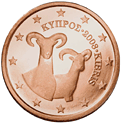
|

|
| The mouflon | ||
| 10¢ | 20¢ | 50¢ |

|
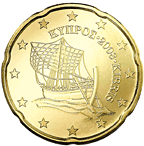
|
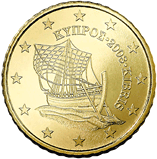
|
| The Kyrenia ship | ||
| €1 | €2 | € 2 Coin Edge |
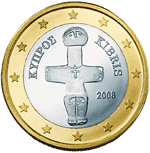
|
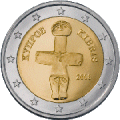
|
|
| The Idol of Pomos | ||
Circulating Mintage quantities[edit]
The following table shows the mintage quantity for all Cypriot euro coins, per denomination, per year.[2]
| Face Value | €0,01 | €0,02 | €0,05 | €0,10 | €0,20 | €0,50 | €1,00 | €2,00 |
|---|---|---|---|---|---|---|---|---|
| 2008 | 40 000 000 | 100 000 000 | 60 000 000 | 70 000 000 | 65 000 000 | 30 000 000 | 28 000 000 | 25 000 000 |
| 2009 | 20 000 000 | 1 000 000 | 6 000 000 | 1 000 000 | 1 000 000 | 1 000 000 | 4 000 000 | 5 000 000 |
| 2010 | 200 000 | 200 000 | 200 000 | 200 000 | 200 000 | 200 000 | 200 000 | 200 000 |
| 2011 | 15 210 000 | 210 000 | 30 210 000 | 210 000 | 210 000 | 210 000 | 210 000 | 210 000 |
| 2012 | 210 000 | 210 000 | 1 000 000 | 1 000 000 | 1 000 000 | 1 000 000 | 1 000 000 | 1 000 000 |
| 2013 | 100 000 | 100 000 | 100 000 | 100 000 | 100 000 | 100 000 | 100 000 | 100 000 |
| 2014 | 100 000 | 100 000 | 100 000 | 100 000 | 100 000 | 100 000 | 100 000 | 100 000 |
| 2015 | 7 100 000 | 100 000 | 100 000 | 100 000 | 100 000 | 100 000 | 100 000 | 100 000 |
| 2016 | 8 007 000 | 100 000 | 100 000 | 100 000 | 100 000 | 100 000 | 100 000 | 100 000 |
| 2017 | 100 000 | 100 000 | 100 000 | 100 000 | 100 000 | 100 000 | 100 000 | 100 000 |
| 2018 | 18 100 000 | 100 000 | 14 100 000 | 100 000 | 100 000 | 100 000 | 100 000 | 7 100 000 |
| 2019 | 11 100 000 | 9 100 000 | 8 100 000 | 5 600 000 | 6 100 000 | 1 400 000 | 100 000 | 1 400 000 |
| 2020 | 8 005 000 | 8 405 000 | 7 505 000 | 1 705 000 | 4 305 000 | 1 505 000 | 105 000 | 3 305 000 |
| 2021 | 9 155 000 | 12 605 000 | 7 955 000 | 4 445 000 | 4 805 000 | 1 925 000 | 1 580 000 | 3 005 000 |
| 2022 | 9 905 000 | 9 755 000 | 8 855 000 | 4 805 000 | 5 165 000 | 1 925 000 | 1 730 000 | 3 755 000 |
Mints[edit]
2008-20: Finland[3]
2010-2018: Greece[3]
Identifying marks[edit]
| National Identifier | "ΚΥΠΡΟΣ (Kypros) and KIBRIS" |
| Mint Mark | None |
| Engravers Initials | None |
| €2 Edge inscription |
Design selection process[edit]
The official public contest for the design of the Cypriot euro coins, which ended on 14 October 2005, defined what the required motifs of the respective coins should encompass:[4]
- 1 cent, 2 cent and 5 cent: The mouflon, the most characteristic species of fauna in Cyprus, representing the island's nature and wildlife.
- 10 cent, 20 cent and 50 cent: The ancient Greek Kyrenia ship of 4th Century B.C., representing Cyprus's history and its character as an island as well as its importance in trade.
- €1 and €2: The Idol of Pomos, a cross-shaped idol dating back to the Cypriot chalcolithic period (3000 B.C.), found in Pomos, a village in the district of Paphos. It is a characteristic example of prehistoric art in Cyprus, representing the island's antiquity, culture and civilization.
American artist Erik Maell and Greek artist Tatiana Soteropoulos were chosen by the Central Bank of Cyprus to create and illustrate the designs to be used for the final coins. The artists were instructed to include the name of Cyprus in Greek and Turkish, that is, ΚΥΠΡΟΣ (Kypros) and KIBRIS in the design for the coins.
Euro adoption[edit]
On 11 October 2006, the final designs of the Cypriot euro coins were presented at the exhibition "Από τη Λίρα στο Ευρώ" ("From the Pound to the Euro") of the Central Bank of Cyprus about the history of currency in Cyprus.[5] They do not appear to include "Cyprus" in English, as demanded by the revised competition rules, but instead only in the state's two official languages, Greek and Turkish.
On 13 February 2007, the Republic of Cyprus formally applied to join the eurozone on 1 January 2008. The final decision was expected to be taken in Brussels on 21–22 June at an EU Summit to be ratified by all EU heads of state.[6]
On 9 March 2007, the campaign to inform the citizens of Cyprus about the euro officially began in Cypriot media.
On 15 March 2007, the House of Representatives passed the necessary laws for the introduction of the euro on 1 January 2008.
On 16 May 2007, the Commissioner for Economic & Financial Affairs of the EU, Joaquín Almunia, recommended that Cyprus adopt the euro as scheduled.
On 20 June 2007, the European Parliament voted affirmatively on this issue and on 21 June 2007, the date was confirmed by the EU leaders.
On 10 July 2007, the EU Finance Ministers set the permanent exchange rate to CYP 0.585274 to 1 euro.
On 23 October 2007, the designs were officially published in the Official Journal of the European Union.[7]
On 1 January 2008, the euro replaced the Cypriot pound as the official currency.
€2 commemorative coins[edit]
Other commemorative coins (Collectors' coins)[edit]
Although Cyprus joined the Eurozone in 2008, they already had one high value commemorative coin, minted in silver. This coin was minted as a legacy of an old national practice of minting gold and silver coins. This coin is not really intended to be used as means of payment, so generally they do not circulate.
See also[edit]
References[edit]
- ^ "National Euro Website: progress achieved, most important dates". Archived from the original on 2007-01-05.
- ^ "Mintage quantities of the euro coins". Euro-Coins.Info. 26 November 2023. Retrieved 2024-02-05.
- ^ a b "Welcome to the Central Bank of Cyprus e-commerce site for numismatic items". Retrieved 2024-02-28.
- ^ "Revised Announcement for the Competition for the Selection of the Design of the National Sides of the Euro Coins". Central bank of Cyprus. Archived from the original on 2007-09-27. Retrieved 2007-02-19.
- ^ ""From the £ to the €" Exhibition". Central bank of Cyprus. Archived from the original on 2007-07-02. Retrieved 2008-01-06.
- ^ "Cyprus files formal application to join the eurozone". Financial Mirror. 2007-02-13. Archived from the original on December 13, 2007. Retrieved 2007-02-13.
- ^ "New national sides of euro circulation coins" (PDF). 2007-10-23. Archived from the original (PDF) on 2008-08-19. Retrieved 2007-11-09.
External links[edit]
- Website of the Central Bank of Cyprus with the final national designs. (Click on the name of each denomination to see the respective design)
- Website for the Euro from the Republic of Cyprus
- European Central Bank – Cyprus
- Cyprus euro coins and commemorative 2€ coins Archived 2021-09-21 at the Wayback Machine
